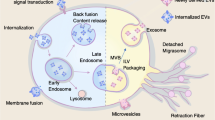Abstract
Extracellular vesicles (EVs) are nanosized lipid bound particles secreted by cells. EVs transfer biologic material and can be found in all body fluids. Accurately characterizing the size and concentration of EVs is difficult because of the nanoscale size of EVs. An evolving solution to this problem is tracking the Brownian motion of EVs in suspension, a technique known as nanoparticle-tracking analysis (NTA). This technique is used by many researchers in the EV field. The ability to accurately replicate data between studies and laboratories is critical to advancing the knowledge surrounding EVs for use in liquid biopsy and cancer studies, in general. Thus, this chapter provides a step-by-step guide on isolating EVs using a variety of methods, for characterizing EVs using the NS300 NTA instrument, troubleshooting tips, and a robust guide to reporting key parameters that will help improve cross-lab reproducibility of NTA data.
Access this chapter
Tax calculation will be finalised at checkout
Purchases are for personal use only
Similar content being viewed by others
References
Chargaff E, West R (1946) The biological significance of the thromboplastic protein of blood. J Biol Chem 166:189–197
Raposo G, Stoorvogel W et al (2013) Extracellular vesicles: exosomes, microvesicles, and friends. J Cell Biol 200:373–383
Colombo M, Raposo G, Théry C (2014) Biogenesis, secretion, and intercellular interactions of exosomes and other extracellular vesicles. Annu Rev Cell Dev Biol 30:255–289
Shojaee S, Caeser R, Buchner M et al (2015) Erk negative feedback control enables pre-B cell transformation and represents a therapeutic target in acute lymphoblastic leukemia. Cancer Cell 28:114–128
Al-Nedawi K, Meehan B, Micallef J et al (2008) Intercellular transfer of the oncogenic receptor EGFRvIII by microvesicles derived from tumour cells. Nat Cell Biol 10:619–624
Yáñez-Mó M, Siljander PRM, Andreu Z et al (2015) Biological properties of extracellular vesicles and their physiological functions. J Extracell Vesicles 4:1–60
Balaj L, Lessard R, Dai L et al (2011) Tumour microvesicles contain retrotransposon elements and amplified oncogene sequences. Nat Commun 2:1–9
García-Romero N, Carrión-Navarro J, Esteban-Rubio S et al (2017) DNA sequences within glioma-derived extracellular vesicles can cross the intact blood-brain barrier and be detected in peripheral blood of patients. Oncotarget 8:1416–1428
Agarwal K, Saji M, Lazaroff SM et al (2015) Analysis of exosome release as a cellular response to MAPK pathway inhibition. Langmuir 31(19):5440–5448
Tamura T, Yoshioka Y, Sakamoto S et al (2021) Extracellular vesicles as a promising biomarker resource in liquid biopsy for cancer. Extracell Vesicles Circ Nucleic Acids 2:148–174
Zhou E, Li Y, Wu F et al (2021) Circulating extracellular vesicles are effective biomarkers for predicting response to cancer therapy. EBioMedicine 67:103365
Longjohn MN, Hudson J-ABJ, Smith NC et al (2020) Deciphering the messages carried by extracellular vesicles in hematological malignancies. Blood Rev 46:100734
Théry C, Aled C, Sebastian A et al (2006) Isolation and characterization of exosomes from cell culture supernatants and biological fluids. Curr Protoc Cell Biol 3(22):1–29
Margolis L, Sadovsky Y (2019) The biology of extracellular vesicles: the known unknowns. PLoS Biol 17:e3000363
Carr B, Wright M (2008) Nanoparticle tracking analysis: a review of applications and usage in the analysis of exosomes and microvesicles
Barba AA, Bochicchio S, Dalmoro A et al (2019) Polymeric and lipid-based systems for controlled drug release: an engineering point of view. Nanomater Drug Deliv Ther :267–304
Lehrich BM, Liang Y, Fiandaca MS (2021) Foetal bovine serum influence on in vitro extracellular vesicle analyses. J Extracell Vesicles 10:e12061
Guerreiro EM, Vestad B, Steffensen LA et al (2018) Efficient extracellular vesicle isolation by combining cell media modifications, ultrafiltration, and size-exclusion chromatography. PLoS One 13:e0204276
Lee YXF, Johansson H, Wood MJA et al (2019) Considerations and implications in the purification of extracellular vesicles – a cautionary tale. Front Neurosci 13:1067
Wang F, Cerione RA, Antonyak MA (2021) Isolation and characterization of extracellular vesicles produced by cell lines. STAR Protoc 2:100295
Auber M, Fröhlich D, Drechsel O et al (2019) Serum-free media supplements carry miRNAs that co-purify with extracellular vesicles. J Extracell Vesicles 8:1656042
Li P, Kaslan M, Lee SH et al (2017) Progress in exosome isolation techniques. Theranostics 7:789
Ingham KC (1984) [20] Protein precipitation with polyethylene glycol. Methods Enzymol 104:351–356
Konoshenko MY, Lekchnov EA, Vlassov AV et al (2018) Isolation of extracellular vesicles: general methodologies and latest trends. Biomed Res Int 2018:8545347
Weng Y, Sui Z, Shan Y et al (2016) Effective isolation of exosomes with polyethylene glycol from cell culture supernatant for in-depth proteome profiling. Analyst 141:4640–4646
Ghosh A, Davey M, Chute IC et al (2014) Rapid isolation of extracellular vesicles from cell culture and biological fluids using a synthetic peptide with specific affinity for heat shock proteins. PLoS One 9:e110443
Roy JW, Taylor CA, Beauregard AP et al (2021) A multiparametric extraction method for Vn96-isolated plasma extracellular vesicles and cell-free DNA that enables multi-omic profiling. Sci Rep 11:1–15
Acknowledgment
We acknowledge the team at Malvern (UK) for training on setup of the NTA and troubleshooting at different stages of the use of the NS300.
Author information
Authors and Affiliations
Corresponding author
Editor information
Editors and Affiliations
Rights and permissions
Copyright information
© 2022 The Author(s), under exclusive license to Springer Science+Business Media, LLC, part of Springer Nature
About this protocol
Cite this protocol
Longjohn, M.N., Christian, S.L. (2022). Characterizing Extracellular Vesicles Using Nanoparticle-Tracking Analysis. In: Christian, S.L. (eds) Cancer Cell Biology. Methods in Molecular Biology, vol 2508. Humana, New York, NY. https://doi.org/10.1007/978-1-0716-2376-3_23
Download citation
DOI: https://doi.org/10.1007/978-1-0716-2376-3_23
Published:
Publisher Name: Humana, New York, NY
Print ISBN: 978-1-0716-2375-6
Online ISBN: 978-1-0716-2376-3
eBook Packages: Springer Protocols




